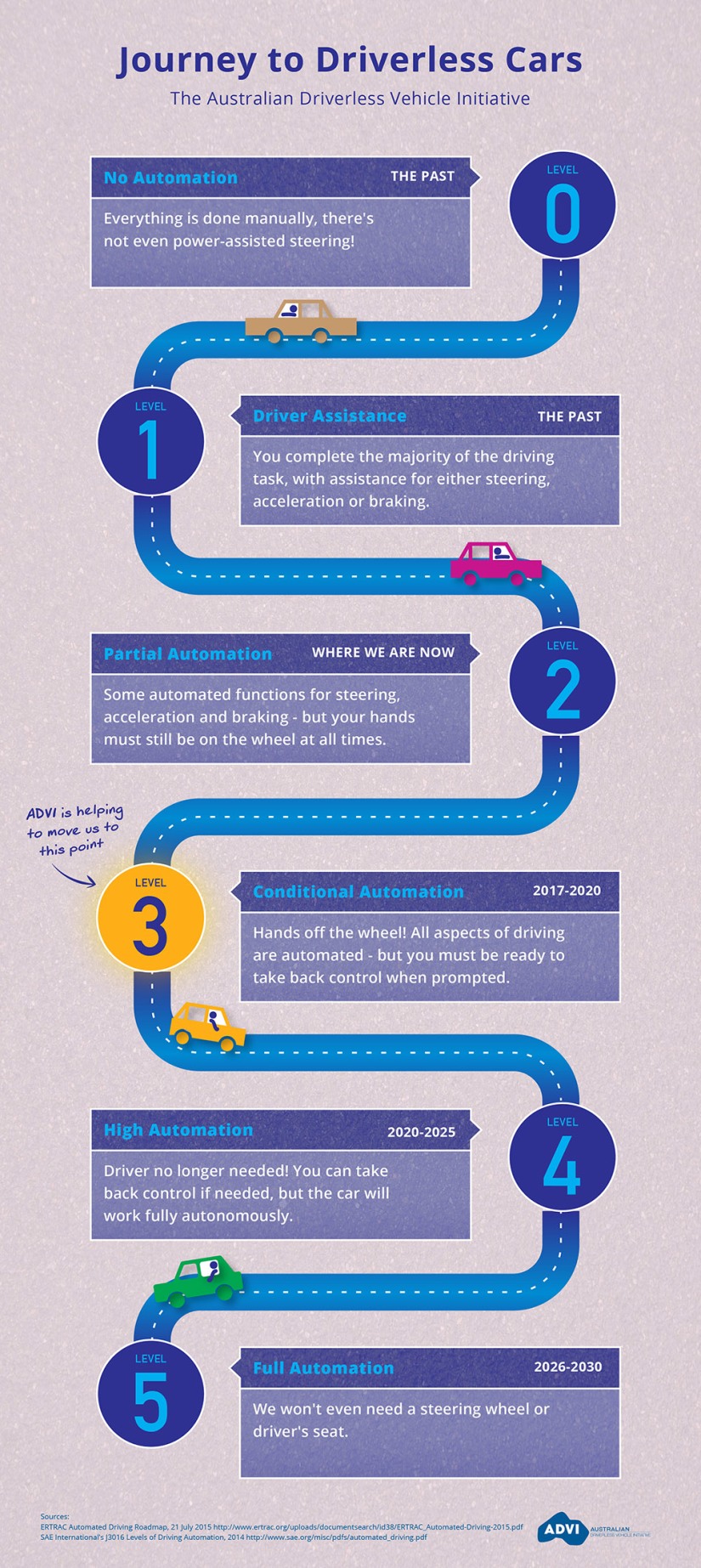With new vehicles now containing basic driver assist features (i.e power steering, cruise control, anti-skid braking) and with high end vehicles offering partial automation features (traffic sensors, auto speed adjustments, auto parking, etc…), it can be seen that the evolution to full automation is both underway and beneficial.
The Australian Driverless Vehicle Initiative, a peak body focused on accelerating the uptake of self-driving vehicles, proposes that “High Automation” vehicles (driver no longer needed) will be on the Australian market and roads by 2020, with “Full Autonomous” vehicles (no steering wheel) to hit the streets by 2026, i.e. in less than ten years…

According to the ADVI “Self-driving vehicles will make driving easier, allow people to be more productive and offer greater mobility to a wider range of people than ever before. They will also help improve road safety, reduce emissions, and ease congestion. As a result, self-driving vehicles will provide significant economic, environmental and social benefits, including improving social inclusion.”
There are many benefits to be gained from the shift to driverless vehicles, namely…
Driverless vehicles increase human safety.
The United States’ National Highway Traffic Safety Administration research estimates that 94 percent of crashes are tied to a human choice or error, a figure that has led experts to predict that autonomous driving will reduce the number of accidents on the road by a similar percentage.
In Australia in 2016, 1295 people were killed in road accidents with annual hospitalised injuries approximately 30 times the rate for fatalities (Australian Road Deaths Database).
The World Health Organisation estimated there were 1.25 million road traffic deaths globally in 2013.
The Australian Government estimates the economic cost of road crashes in Australia is $27 billion per annum—and the social impacts are devastating (Road Safety).
From this it can be proposed that driverless vehicles have the capacity to reduce by 94% road accident fatalities, injuries, and expenditure, with the following estimates:
- Save 1,243 lives in Australia and 1.2 million lives Globally per annum.
- Avoid injuries to 37,296 people in Australia and tens of millions Globally per annum.
- Save the Australian community $25.92 billion per annum.
Already, automobiles with forward collision warning systems that alert drivers or automatically brake are involved in far fewer crashes.
Driverless vehicles will give us more free time.
Its estimated that the average Australian commute is over an hour to and from work, which accumulates into over 250 hours a year.
By relinquishing control of the vehicle to autonomous systems drivers will be able to safely use the journey time however they wish, from catching up on work, to Skyping with friends and family, or surfing the web, reading a book, or just chatting face to face with other passengers.
In addition, with smarter traffic grids, networked and pontooned autonomous driving and other advances, it may be that we find ourselves spending less time commuting that we do now.
Driverless vehicles would result in less traffic and reduced emissions
Driverless Vehicles are able to communicate with each other and other traffic systems to determine (and take) the optimal, quickest and most economical route. Vehicles could communicate with roadside infrastructure such as traffic lights and use this information to minimise fuel consumption and emissions.
Driverless Vehicles can pontoon (safely sit 10cm behind vehicle in front) to reduce drag, increase vehicle volumes on roads (an estimate of “up to four times as many vehicles could travel on existing highways if all vehicles were automated” was given by the Texas Transportation Institute) and increase safe speeds. Pontooning would result in further reductions in fuel consumption and emissions.
It’s clear that the transformation to fully autonomous vehicles is well under way, and that the benefits that come with this shift will make it both compelling and undeniable.
A driverless future
When combined with the digital sharing economy and electrification of vehicles it becomes clearer that the days of everyone owning a car or two are ending. In there place we will see the continued rise of personal transport as:
- a service (from you mobile phone, i.e. auto-Uber)
- with declining costs (remove driver cost, and significantly reduce fuel and maintenance cost with electric autonomous vehicles)
…which will make personal transport safe (for passengers, pedestrians, wildlife), cheap and available to all (especially children and the elderly), convenient, and time saving.
Its not a bad deal.
